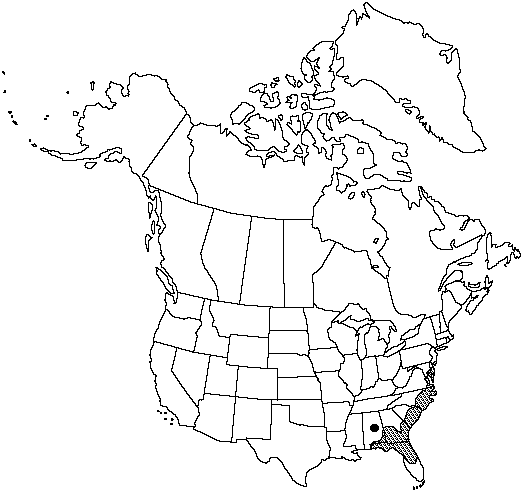Pinus serotina
Fl. Bor.-Amer. 2: 205. 1803.
Trees to 21m; trunk to 0.6m diam., straight or more often crooked, commonly with adventitious sprouts; crown becoming ragged, thin, often broadly rounded or flat. Bark red-brown, irregularly furrowed and cross-checked into rectangular, flat, scaly plates. Branches spreading to ascending; twigs stout, orange- to yellow-orange, frequently glaucous, aging darker. Buds ovoid to narrowly ovoid, red-brown, 1–1.5(–2)cm, resinous. Leaves 3 per fascicle (to 5 in adventitious or disturbed growth), spreading to ascending, persisting 2–3 years, (12–)15–20(–21)cm × 1.3–1.5(–2)mm, slightly twisted, tufted at twig tips, straight, yellow-green, all surfaces with fine stomatal lines, margins serrulate, apex acuminate; sheath 1–2cm, base persistent. Pollen cones cylindric, to 30mm, yellow-brown. Seed cones maturing in 2 years, in some populations beginning to shed seeds then but more often variably serotinous, long-persistent, often whorled, symmetric, ovoid to lanceoloid before opening, broadly ovoid to nearly globose when open, 5–8cm, pale red-brown to creamy brown, sessile or on stalks to 1cm, scales with dark red-brown border on adaxial surface distally; apophyses slightly thickened, low, rhombic, low cross-keeled; umbo central, low-conic, with short, weak prickle, sometimes unarmed. Seeds ellipsoid, oblique at tip, somewhat compressed; body 5–6mm, pale brown, mottled darker or nearly black; wing to 20mm. 2n =24.
Habitat: Flatwoods, flatwoods bogs, savannas, and barrens
Elevation: 0–200m
Distribution

Ala., Del., Fla., Ga., Md., N.J., N.C., S.C., Va.
Discussion
Pinus serotina is fire successional and sprouts adventitiously after crown fires. It is part of a distinct forest type including Taxodium distichum (Linnaeus) Richard, Nyssa biflora Walter, Magnolia virginiana Linnaeus, Persea sp., and Ilex sp. Of good form when protected from fire, P. serotina then much resembles P. taeda, with which it hybridizes naturally. It is of increasing importance as pulpwood.
Selected References
None.